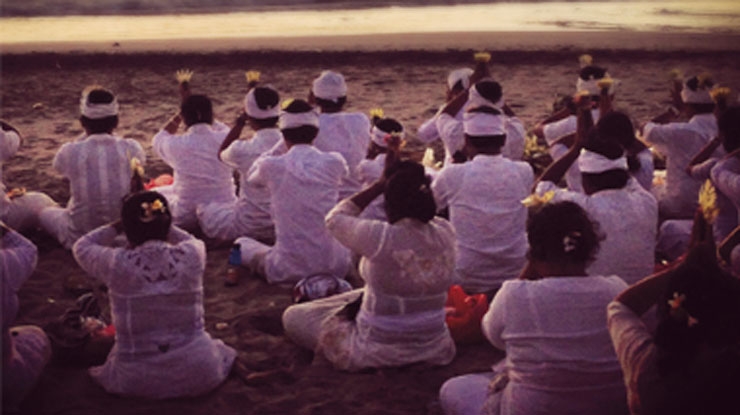The practice of oath taking is very common among the Balinese. It takes the form of barter. “If I am bestowed this favour from the gods, I will fulfil such and such a promise”. It can also apply to a promise between humans. “If I get what I wish for, I will do this for you”. In both cases, the fulfilment of the vow is mandatory.

The Balinese call it “Sauh Munyi” or “Sauh Wacana,” which means literally “a slip of words”. Once the vow is made, it has to be implemented, “naur sesangi/sauh,” as the Balinese say. To break one’s word is an unpardonable sin – “Lipia Wecana” – which has to be “atoned for” later by a catastrophe – “upadrawa” – or by a heavy karma burden.
An oath can be taken in many places and in many ways. Sometimes it is through a prayer addressed to the Ultimate Teacher, the Lord of the Ancestors, Sang Hyang Batara Guru, but it can also be taken by addressing the “owner” that dwells in a large tree or the Sesuhunan god that dwells in any shrine.
A vow might also be made in a very general way, without the intermediary of a shrine or a ceremony, although ceremonies are favoured when “witnessed” by the gods. It is not unusual for a couple to make a vow before engaging in sexual intercourse. Many people also take their vows through a balian (shaman). He is thought to be able to channel within himself, through the entreaties of an especially powerful shrine, a Sesuhunan god that endows him with strong magical powers. Because of these powers customer’s throng to him to beseech him to bestow on them the favours of the gods.
The Balinese sometimes make vows in relation to illnesses. An example could be “If my child recovers from that “magical” illness, we will all go to pray in the Besakih temple (Yen pianak tiange luput uli asangan nenenan, tiang ngajak onyangan lakar ngaturang sembah ke pura Besakih). Often also, the Balinese make vows in relation to their fertility – if they don’t have children, for example, or if they want to have a boy or a girl. Some people, who have had only girls, and thus have no inheritor for their shrine, may say: “If I get a boy, I will welcome him with two roasted pigs” (dumadak apang tiang ngelah pianak muani, lakar magpag baan guling dadua). On other occasions, the terms of the vow can be much more important and expensive: “If I get a boy, I will hold a wayang kulit puppet show” (Dumadak kurenan tiange ngelekadang anak muani, tiang sanggup lakar ngupah wayang kulit).
When the vow is taken in relation to an expected birth, it is usually “paid” when the infant reaches the “nyambutin” (welcome stage), on the 105th day after its birth. At that time the child takes a name and is introduced into human society. For the others, it depends on the nature of the vow itself. If the vow was made through a balian, the avowed feels bound to the latter, and brings him regular “banten” (offerings) and “sesari” (money).
In the village of Wongaya Gede, at the foot of the Batukaru, it is common for the people to promise to hold a Joged dance upon the birth of an expected child. The Joged is very popular in Tabanan and all over Bali because it is a dance where girl Joged dancers coax and invite boys onto the stage to dance with them in a manner of mock seduction. In Wongaya Gede the Joged dance is of a peculiar type as it has a religious connotation. It takes place on the evening after the nyambutin welcome ceremony in the house of the family of the newly born boy. Its peculiarity lies in the fact that the first “man” to be invited by the Joged dancer is the baby itself.
Since the baby cannot dance, he is taken to the dancing ground by his father who plays with his hands as if he were dancing and trying to approach the girl. Unlike ordinary Joged dances, which are usually boisterous affairs, no one is allowed to shout in this case, since it is a sacred dance.
After the child has finished “dancing,” a flower is slipped behind his ear, to symbolise the god of love incarnated – Smara. Then, holy water, which is thought to have been produced by the dance, is sprinkled on the child. This Joged from Wongaya Gede illustrates the extent to which dances are tied to religion.









